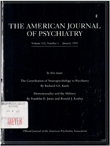Partial hospitalization (day treatment) for psychiatrically ill elderly patients
Abstract
OBJECTIVE: The purpose of this paper is to present initial findings from a retrospective chart review of geriatric day treatment patients in order to focus attention on this potentially important area, add to the limited database in this area, and generate hypotheses for future investigations. METHOD: Data were abstracted from the charts of 100 geriatric day treatment patients over a period of approximately 5 years (1985-1989). Descriptive, univariate, and multiple regression techniques were used to describe the patients and identify variables associated with their outcomes. RESULTS: The typical patient in this program was a widowed white woman in her 70s who suffered from a depressive disorder. During the initial treatment period (usually approximately 3 months), 57% of the patients experienced some clinical improvement. Variables associated with a favorable outcome included diagnosis of a mood disorder rather than a psychotic disorder, better initial functional status, greater initial social support, fewer stressful events during treatment, and longer duration of treatment. CONCLUSIONS: Geriatric day treatment can be effective and merits further study as a mode of treatment for psychiatrically ill elderly patients.
Access content
To read the fulltext, please use one of the options below to sign in or purchase access.- Personal login
- Institutional Login
- Sign in via OpenAthens
- Register for access
-
Please login/register if you wish to pair your device and check access availability.
Not a subscriber?
PsychiatryOnline subscription options offer access to the DSM-5 library, books, journals, CME, and patient resources. This all-in-one virtual library provides psychiatrists and mental health professionals with key resources for diagnosis, treatment, research, and professional development.
Need more help? PsychiatryOnline Customer Service may be reached by emailing [email protected] or by calling 800-368-5777 (in the U.S.) or 703-907-7322 (outside the U.S.).



